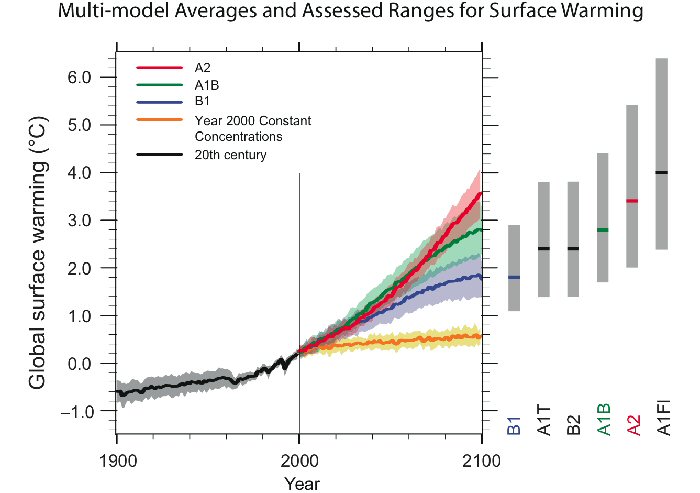
| North American Regional Climate Change Assessment Program |
| The A2 Emissions Scenario |
|
Because we had limited funding for NARCCAP, we decided to focus on the uncertainty across different AOGCMs and RCMs. Hence, we chose to use only one emissions scenario, which is used for all simulations. We chose the A2 emissions scenario since it was one of the 'marker' scenarios developed through the IPCC and was a common one used at the time NARCCAP was being planned. The scenario is one described in Nakicenvoic et al. (2000) in the Special Report on Emissions Scenarios (SRES) that was commissioned by the IPCC. Some of the scenarios described in that volume have been used in the climate model simulations assessed in both the IPCC 2001 and 2007 reports. The A2 scenario is at the higher end of the SRES emissions scenarios (but not the highest), and this was preferred because, from an impacts and adaptation point of view, if one can adapt to a larger climate change, then the smaller climate changes of the lower end scenarios can also be adapted to. A low emissions scenario potentially gives less information from an impacts and adaptation point of view. In addition, the current actual trajectory of emissions (1990 to present) corresponds to a relatively high emissions scenario.
We present here a brief summary of the major characteristics of the scenario. The SRES scenarios were developed by considering various possible futures of world development in the 21st century, including such factors as economic development, technological development, energy use, population change, and land-use change. Four major story lines or about world development were developed, which were quantified into four scenarios families, and a total of 40 different scenarios across the four story lines/families were constructed. The authors of the SRES scenarios consider all scenarios to be equally plausible and they did not assign any probabilities to them. The A2 story line is characterized by heterogeneity. Self reliance and local identities are emphasized, and population increases continuously. Population reaches over 10 billion by 2050. Economic development is regionally oriented and economic and technological development is relatively slow, compared to the other story lines. From these major factors, and using Integrated Assessment Models (IAMs), emissions of the major greenhouse gases were developed for the 21st century. Cumulative CO2 emissions by the middle and end of the 21st century are projected to be about 600 and 1850 GtC respectively, and expected CO2 concentrations (in parts per million, ppm) for the middle and end of the 21st century in this scenario are about 575 and 870 ppm, respectively. The current concentration of CO2 is about 380 ppm. Methane and nitrous oxide increases grow rapidly in the 21st century. Sulfur dioxide increases to a maximum value just before 2050 (105 MtS/yr) and then decreases in the second half of the century (60 MtS/yr by 2100). ReferenceNakicenovic et al., 2000. Special Report on Emissions Scenarios. A Special Report of Working Group III of the Intergovernmental Panel on Climate Change. Cambridge University Press: Cambridge. 599 pp. |






